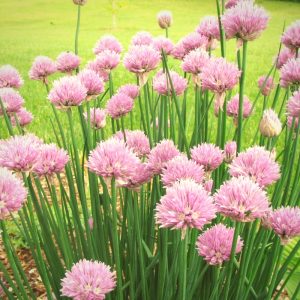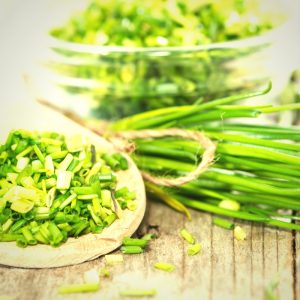
Known as common garden chives, Allium schoenoprasum, can be grown indoors and out. Chives are rich in vitamins A and C, potassium, and calcium. They are grown for the flavour of their leaves, which is reminiscent of onion, although much milder. Both the stems and light purple flowers are used in cooking and the snipped leaves are an addition to many dishes. Chives lose their flavour with long cooking so it is best to add them to dishes at the last minute. For chopping stems, a pair of scissors is the best tool.
 Chives can be frozen or dried. They are less flavourful when dried rather that frozen, so they are best used when fresh and snipped, or snipped and frozen. In both cases sort them carefully, removing any yellowing leaves and shoots, and keep only the plump green ones. It is possible to place chives in non-iodized salt, keep them there for several weeks, remove the leaves, and then bottle the ‘chive salt’ for use in flavouring.
Chives can be frozen or dried. They are less flavourful when dried rather that frozen, so they are best used when fresh and snipped, or snipped and frozen. In both cases sort them carefully, removing any yellowing leaves and shoots, and keep only the plump green ones. It is possible to place chives in non-iodized salt, keep them there for several weeks, remove the leaves, and then bottle the ‘chive salt’ for use in flavouring.
Chives are a perennial in the garden and grow approximately 12 inches (30 cm) tall. They are extremely easy to grow, are drought tolerant, rarely suffer from disease or pest problems, and don’t require fertilizer. Cultivation requirements for growing chives: full sun, will tolerate light shade; grow best in well-drained, organic, fertile soil; keep soil moist – use mulch, and water during periods of drought. Chives tend to get overcrowded so dig and divide every three to four years.
Chives are perfect for edible landscape borders, learn more about edible landscaping here
Chives are easily grown from seed or can be brought indoors at the end of the growing season. If you are bringing chives indoors, divide a clump, and pot up in good houseplant soil. Leave your chive plant outdoors for a month or so after the first frost to provide a short period of dormancy. Bring them indoors and provide the requirements needed for them to start growing again. To harvest, snip leaves 2 inches (5cm) from the base of the plant. Cut flower stalks off at the soil line once they have finished blooming. This prevents the plant form forming seed and keeps it more productive.
 Chives require at least five to eight hours of sunlight a day. Grow them on a southern or eastern exposure to the light. If you are growing them on a windowsill, turn regularly to ensure every side receives light. If you are unable to provide this amount of light, they also grow well under fluorescent lights. Hang lights 6 inches above the plants and leave lights on for 14 hours per day.
Chives require at least five to eight hours of sunlight a day. Grow them on a southern or eastern exposure to the light. If you are growing them on a windowsill, turn regularly to ensure every side receives light. If you are unable to provide this amount of light, they also grow well under fluorescent lights. Hang lights 6 inches above the plants and leave lights on for 14 hours per day.
In the garden, plant chives with carrots. They are good companion plantings for tomatoes and fruit trees. Chives or garlic planted between rows of peas or lettuce control pashas and are reported to control the incidence of aphids when planted between roses. In the kitchen, use chives in omelets, scrambled eggs, casseroles, rice, dips, gravies, butter, meat, and seafood. Chives can be added to soft cheese, salads, sandwiches, sour cream, vinegar, and bake potatoes. Chive blossoms can be used for garnishing and are particularly attractive in salads. Chive stems can be used for tying up little bundles of vegetables for appetizers.
The post Chives – Allium schoenoprasum appeared first on All around the house.
from All around the house http://allaroundthe.house/chives/
via IFTTT
Comments
Post a Comment